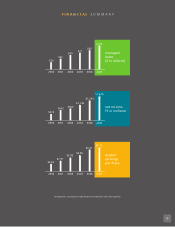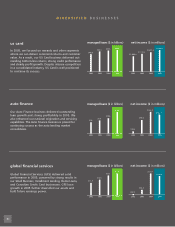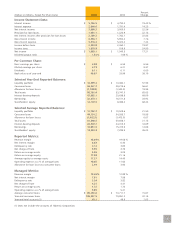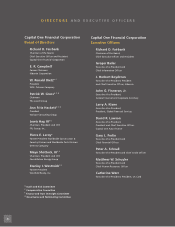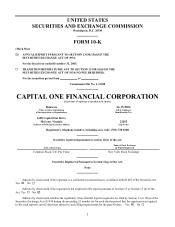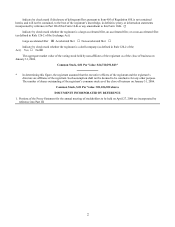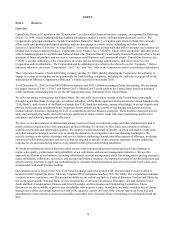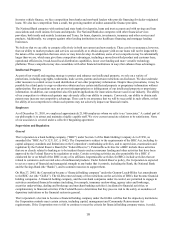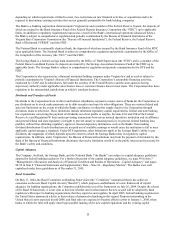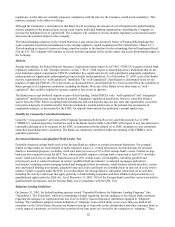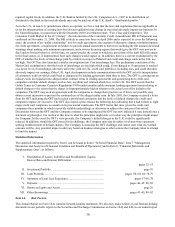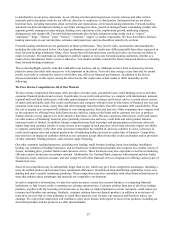Capital One 2005 Annual Report Download - page 16
Download and view the complete annual report
Please find page 16 of the 2005 Capital One annual report below. You can navigate through the pages in the report by either clicking on the pages listed below, or by using the keyword search tool below to find specific information within the annual report.C
redit Risk Management
Successful management of credit risk, the risk that borrowers may default on their financial obligations to the Company, is
critical to the Company’ s success. There are four primary sources of credit risk: (1) changing economic conditions, which
affect customers’ ability to pay; (2) changing competitive environment, which affects customer debt loads and borrowing
patterns; (3) the Company’ s underwriting strategies and standards, which determine to whom we offer credit and on what
terms; and (4) the quality of the Company’ s internal controls, which establish a process to test that underwriting conforms to
Company standards and identify credit quality issues so the Company can act upon them a timely manner. The Company is
cused on managing each of these sources of credit risk. fo
The Company’ s Chief Credit Officer is charged with overall management of credit risk. The goal is to provide strong central
oversight of credit policy and credit programs while maintaining the ability of operating units to respond flexibly to changing
market and competitive conditions. The Company’ s Chief Credit Officer manages a corporate Credit Risk Management staff
and chairs the Credit Policy Committee, a committee of senior management. The Credit Policy Committee oversees and
approves corporate credit policy and credit performance. Its members include the Chief Credit Officer, the Chief Enterprise
Risk Officer, the Controller and the Presidents of the Company’ s three operating segments. Beginning in the first quarter of
2006, a new banking segment will be disclosed and the President of that segment will be a member of the Credit Policy
Committee. The Credit Policy Committee also has sub-committees which provide credit oversight at the divisional level. The
Chief Credit Officer, his staff, or the appropriate credit committee reviews and approves all large scale new credit programs.
Smaller credit decisions are approved by credit officers appointed by the credit committee(s) and supervised by the Credit
Risk Management organization. It is expected that all credit programs will also be approved by the appropriate operating
executives. These organizational structures are designed so that each of the Company’ s business units applies standardized
practices in measuring and managing credit risk, and that all relevant factors, such as credit outlook, profitability, and the
ompetitive, economic, and regulatory environment, are considered in making credit decisions. c
The Board of Directors has established policies that limit the level and composition of risk in the total lending portfolio. The
Company’ s Credit Policy Committee has established policies that govern credit administration and individual lending
ecisions. The centralized Credit Risk Management group monitors overall composition and quality of the credit portfolio. d
The Company’ s credit risk profile is managed to maintain resilience to factors outside of the Company’ s control, strong risk-
adjusted returns, and increased diversification.
The Company’ s guiding principles, strong central governance, and Board-directed credit risk tolerances are designed to keep
senior executives well-informed of credit trends so they can make appropriate credit and business decisions for the Company.
The Company enhances/preserves day-to-day market responsiveness and flexibility by empowering its business line
managers to develop credit strategies and programs aligned with the Company’ s credit risk policies and objective of long-
term business profitability. The credit program development process considers the evolving needs of the target market, the
ompetitive environment, and the economic outlook. c
Most of the Company’ s consumer credit strategies rely heavily on the use of sophisticated proprietary scoring models. These
models consider many variables, including credit scores developed by nationally recognized scoring firms. The models are
validated, monitored and maintained in accordance with detailed policies and procedures to help maintain their continued
validity. The Company’ s Chief Scoring Officer, a member of the Chief Credit Officer’ s staff, oversees the development,
implementation and maintenance of key statistical models.
Liquidity Risk Management
Liquidity risk refers to exposures generated from the use and availability of various funding sources to meet its current and
future operating needs. The management of liquidity risk is overseen by the Chief Financial Officer with the advice and
guidance from the Asset and Liability Management Committee and its sub-committee on funding chaired by the Treasurer.
The Company currently manages and mitigates its liquidity risk through the use of a variety of funding sources to establish a
maturity pattern that provides a prudent mixture of short-term and long-term funds. See page 46 in Item 7 “Management’ s
Discussion and Analysis of Financial Condition and Results of Operations—Liquidity Risk Management” for additional
information.
Market Risk Management
Market risk refers to exposures generated from changes in interest rates and foreign currency exchange rates. The
management of market risk is overseen by the Chief Financial Officer with the advice and guidance from the Asset and
Liability Management Committee. The Company currently manages and mitigates its interest rate sensitivity through several
techniques, which include, but are not limited to, managing the maturity and repricing characteristics of assets and liabilities
7


